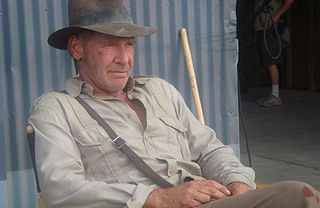
Dr. Henry Walton "Indiana" Jones, Jr. is the title character and protagonist of the Indiana Jones franchise. George Lucas created the character in homage to the action heroes of 1930s film serials. The character first appeared in the 1981 film Raiders of the Lost Ark, to be followed by Indiana Jones and the Temple of Doom in 1984, Indiana Jones and the Last Crusade in 1989, The Young Indiana Jones Chronicles from 1992 to 1996, Indiana Jones and the Kingdom of the Crystal Skull in 2008, and Indiana Jones and the Dial of Destiny in 2023. The character is also featured in novels, comics, video games, and other media. Jones is also the inspiration for several Disney theme park attractions, including Indiana Jones and the Temple of Peril, the Indiana Jones Adventure, and Epic Stunt Spectacular! attractions.

A sequel is a work of literature, film, theater, television, music, or video game that continues the story of, or expands upon, some earlier work. In the common context of a narrative work of fiction, a sequel portrays events set in the same fictional universe as an earlier work, usually chronologically following the events of that work.
An alternate reality game (ARG) is an interactive networked narrative that uses the real world as a platform and employs transmedia storytelling to deliver a story that may be altered by players' ideas or actions.
Technological convergence is the tendency for technologies that were originally unrelated to become more closely integrated and even unified as they develop and advance. For example, watches, telephones, television, computers, and social media platforms began as separate and mostly unrelated technologies, but have converged in many ways into an interrelated telecommunication, media, and technology industry.
A tie-in work is a work of fiction or other product based on a media property such as a film, video game, television series, board game, web site, role-playing game or literary property. Tie-ins are authorized by the owners of the original property, and are a form of cross-promotion used primarily to generate additional income from that property and to promote its visibility.
Narratology is the study of narrative and narrative structure and the ways that these affect human perception. The term is an anglicisation of French narratologie, coined by Tzvetan Todorov. Its theoretical lineage is traceable to Aristotle (Poetics) but modern narratology is agreed to have begun with the Russian formalists, particularly Vladimir Propp, and Mikhail Bakhtin's theories of heteroglossia, dialogism, and the chronotope first presented in The Dialogic Imagination (1975).

Henry Guy Jenkins III is an American media scholar and Provost Professor of Communication, Journalism, and Cinematic Arts, a joint professorship at the University of Southern California (USC) Annenberg School for Communication and Journalism and the USC School of Cinematic Arts. He also has a joint faculty appointment with the USC Rossier School of Education. Previously, Jenkins was the Peter de Florez Professor of Humanities as well as co-founder and co-director of the Comparative Media Studies program at the Massachusetts Institute of Technology (MIT). He has also served on the technical advisory board at ZeniMax Media, parent company of video game publisher Bethesda Softworks. In 2013, he was appointed to the board that selects the prestigious Peabody Award winners.

Janet Claire Mahoney, known professionally as Janet Fielding, is an Australian actress who starred in the BBC science fiction television series Doctor Who as companion Tegan Jovanka.
A media franchise, also known as a multimedia franchise, is a collection of related media in which several derivative works have been produced from an original creative work of fiction, such as a film, a work of literature, a television program or a video game. Bob Iger, chief executive of the Walt Disney Company, defined the word franchise as "something that creates value across multiple businesses and across multiple territories over a long period of time".

Ramona Pringle is a Canadian digital journalist, television host, multiplatform media producer, actress and professor. Currently she is the Director of the Transmedia Zone at Toronto Metropolitan University, an incubator for innovation in media, and a Technology Columnist for CBC.
Transmedia storytelling is the technique of telling a single story or story experience across multiple platforms and formats using current digital technologies.

Dreaming in Mono is a transmedia storytelling branded content initiative from McDonald's and Perfect Fools, produced by Happy Fiction, in the four Nordic countries of Denmark, Finland, Norway and Sweden. The story combines three principle themes: the Nordic passion for winter sports; the prejudices, rivalries and stereotypes of the Nordic nations; the role of McDonald's as the largest host of diverse people and fun experiences in the region.
Richard Keith Berman is an American television producer and screenwriter. He is best known for his work as the executive producer of several of the Star Trek television series: Star Trek: The Next Generation, Star Trek: Deep Space Nine, Star Trek: Voyager and Star Trek: Enterprise, as well as several of the Star Trek films, and for ultimately succeeding Gene Roddenberry as head of the Star Trek franchise until the cancellation of Star Trek: Enterprise in 2005.
Transmediality is a term used in intermediality studies, narratology, and new media studies (in particular in the phrase ‘transmedia storytelling’ derived from Henry Jenkins, to describe phenomena which are non-media specific, meaning not connected to a specific medium, and can therefore be realized in a large number of different media, such as literature, art, film, or music. The medium from which a given phenomenon originated is either irrelevant or impossible to determine; it is not an adaptation of a phenomenon from one medium to another.
Nuno Bernardo is a Portuguese writer, producer and director. Nuno has become recognized for his ability to create innovative stories that are told across multiple platforms. In the last decade, using his unique approach to storytelling, Nuno has created and produced more than 200 hours of entertainment, from feature films and TV shows to videogames and books.
The following outline is provided as an overview of and topical guide to George R. R. Martin's A Song of Ice and Fire media franchise:

The Chosen is an American Christian historical drama television series. Created, directed, and co-written by filmmaker Dallas Jenkins, it is the first multi-season series about the life and ministry of Jesus of Nazareth. Primarily set in Judaea and Galilee in the 1st century, the series centers on Jesus and the people who met and followed him. The series stars Jonathan Roumie as Jesus as well as Shahar Isaac, Elizabeth Tabish, Paras Patel, Noah James, and George H. Xanthis.
Convergence culture is a theory which recognizes changing relationships and experiences with new media. Henry Jenkins is accepted by media academics to be the father of the term with his book Convergence Culture: Where Old and New Media Collide. It explores the flow of content distributed across various intersections of media, industries and audiences, presenting a back and forth power struggle over the distribution and control of content.

Secret Story Network is an online interactive storytelling experience which operates live role-playing games. Hosted over WhatsApp, SSN was created in 2017 by film, multimedia, and transmedia artist Krishna Stott, creative developer at Bellyfeel, and known for the earlier award-winning interactive film projects Crimeface (2008) and Bolton Storyworld: Codename Winterhill (2016).
Jay Bushman is an American transmedia writer and book author.







